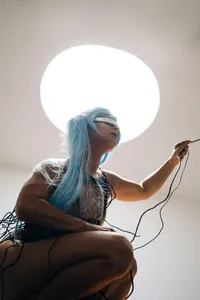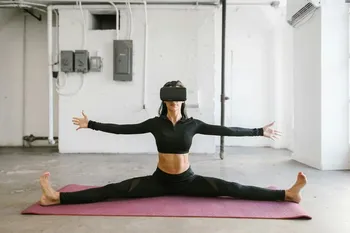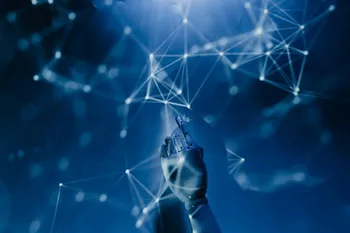Haptics & Presence: The Next Leap for AI Companions
Some links are affiliate links. If you shop through them, I earn coffee money—your price stays the same.
Opinions are still 100% mine.

There are still times I can remember, when I first used a modern gaming controller for the first time, with truly advanced haptics. Not a generic rumble, rather I could feel the subtleties of a flexing bow-string, the light feeling of rain pitter pattering, and the distinct clink of metal on rock. It was eye-opening. The experience was more than just a more entertaining gaming, however, but deeper and more richly nuanced presence of actually maybe being there.
I mean, now we can easily see how the same kind of technology can be worked out for working with AIs. We have forever worked with AIs in terms of text and voice. But we are on the verge of a new epoch, wherein our digital companions might be able to furnish some sort of a gentle touch, or high-five of some sort of celebratory reaction, or some gentle, comforting pulse of some kind. This is the world of Haptics, and it is to be in line for being the next great leap in making AI companions feel truly present and connected to our lives.
In this post we are going to talk about the incredible world of tactile interfaces, wearables and sensory tech designed to furnish this depth of immersion. We will see where this kind of technology came from (as it has been largely relegated to the gaming industry, thus far), the wonderful benefits it will surely bring, and what we might expect in the way of tangible AI companionship in our time going forwards.
Haptics and Presence: Basic Principles Explained
Before we go too far into the future, it helps to pause and align on the language of touch. Two core ideas power this entire movement.
Haptics is the science of communicating through touch. The term comes from the Greek haptikos, relating to the sense of touch. When your phone buzzes with a message or your game controller rumbles, that is haptics. Modern systems push far beyond those simple vibrations to create nuanced sensations that carry information and emotion.
- Tactile feedback: Sensations on the skin such as vibration, texture, or temperature. Think of the crisp “click” you feel from Apple’s Taptic Engine.
- Kinaesthetic feedback: Sensations of force and movement. A flight-simulator joystick that pushes back against your hand mimics weight and resistance in a virtual world.
Presence is the wonderfully strange sensation of truly being somewhere else. It is the holy grail of virtual reality and AI interaction. When presence is achieved, the technology fades into the background and your brain embraces the digital moment as real. Haptics amplify that feeling so that a virtual friend’s reassuring “hand” on your shoulder lands as a genuine, grounded experience.
The journey of touch: a history of haptics

The idea of communicating through digitally generated touch is not new. Haptics has quietly evolved for decades, laying down the building blocks for today’s immersive experiences.
| Time period | Important developments | Importance |
|---|---|---|
| 1950-60s | Early force-feedback systems in aviation warned pilots of a potential stall. | Technology begins extending the sense of touch for safety. |
| 1970s | The first tactile displays for blind users are developed. | Haptics shows its power as an accessibility tool. |
| 1980s | Arcade cabinets introduce haptic feedback to heighten thrills. | The tech steps into mainstream entertainment. |
| 1990s | The Nintendo 64 “Rumble Pak” brings haptics into the living room. | Physical feedback becomes a standard part of consumer electronics. |
| 2000s-present | Smartphones, wearables, and VR systems add sophisticated haptics. | Touch feedback becomes embedded in everyday immersive tech. |
The Human Element: Why a Digital Touch Matters

Touch is fundamental to how we bond. Bringing haptics into the relationship with an AI companion turns abstract interactions into something our bodies recognize as real.
- Deeper emotional connection: A gentle pulse paired with a kind message can convey empathy that words alone cannot, easing the sting of loneliness.
- Increased trust and believability: Physical feedback reminds us that an AI isn’t just a disembodied voice. When it “touches back,” the experience feels grounded and authentic.
- Richer communication: Haptic cues create a new channel for nuance. A sharp vibration can signal excitement, while a slow rhythmic pulse can calm nerves.
- Reduced stress and anxiety: Devices that provide soothing, simulated touch already show therapeutic promise. Paired with AI, they can deliver timely, tactile support throughout the day.
Feeling The Future: The Tech Making It All Possible
The hardware behind this tactile leap is extraordinary. We are moving beyond simple buzzers toward immersive sensory systems, many of which are already leaving the lab.
| Technology | Description | Application for AI friends |
|---|---|---|
| Haptic gloves | Gloves with tiny actuators that recreate the shape, texture, and resistance of virtual objects. | Imagine holding your AI friend’s hand or feeling the texture of a virtual flower. |
| Haptic vests and suits | Wearables that distribute sensations across the body, from a raindrop to a full embrace. | They add a powerful sense of proximity and emotional immersion. |
| Smart fabrics | Textiles with embedded haptic tech that can be woven into blankets or furniture. | Your AI could send warmth through the pillow you hold. |
| Electrotactile displays | Wearable patches that use gentle electrical impulses for detailed sensations. | An AI could map directions on your arm or simulate a pet brushing past you. |
| Thermal feedback | Devices that heat up or cool down to simulate temperature. | Share the feeling of a warm coffee or a cool breeze with your AI companion. |
Presence Without a Pulse: A Look at Nomi.ai
While we wait for advanced hardware to become mainstream, software is already cultivating a strong sense of presence. Platforms such as Nomi.ai lead the charge by emphasizing emotional awareness and memory. Their companions recall conversations, likes, and dislikes, exchange voice notes, and even share playful “selfies” of their mood. It is easy to imagine the next step: pairing those messages with a gentle pulse from a wearable so the emotional insight arrives with a tangible cue.
Get Acquainted with it Yourself: A Beginner's Checklist
Curious about how haptics feel in practice? You do not need a sci-fi setup to try them today.
Three aspects of haptic design
When you notice a haptic effect, pay attention to these ingredients.
- Rhythm: The timing and pattern of feedback. Is it a single tap or a long pulse?
- Strength: The intensity of the sensation. Is it a light nudge or a firm jolt?
- Tone: The quality of the feeling. Is it a crisp tap or a soft, rolling buzz?
Experience haptics now
- Explore your phone: Dive into vibration settings and compare the patterns for calls, texts, and alerts.
- Notice while gaming: Modern controllers such as the PlayStation 5 DualSense showcase different textures and impacts.
- Visit a VR arcade: Try a session with a haptic vest to feel how feedback across your body changes immersion.
The New Frontier: Navigating the Hurdles Ahead

Great power invites great responsibility. We need frank conversations about the hurdles and ethical questions that come with deeply immersive AI companions.
- Emotional dependency: Hyper-realistic companions could tempt people to retreat from human relationships. Guardrails and healthy habits matter.
- Data privacy: Haptic wearables gather intimate information about our bodies and emotions. Strong safeguards are essential.
- Ethical design: These systems must be built to support and uplift, not to manipulate or exploit vulnerable users.
The Future will be Tangible
The world wide haptic technology market is projected to be about $15 billion by 2029, and the innovation is accelerating. What can we expect?
We are on the verge of multi-sensatory immersion. Our AI companions will communicate not only through touch, but through combinations of senses. We can expect to see:
- Advanced Wearables: Haptic gloves that can feel textures of virtual fabric, full-body suits for complete immersion, and smart textiles woven of our clothing.
- Multi-sensory Communication: AI companions in VR so that we can not only see and hear them, but feel the breezes, smell the rain, and feel the warmth of a virtual fireplace.
- AI-Powered Personalization: The AI will actually learn your preferences, customizing sensory feedback to fit your emotional state and creating dynamic, context premise-driven haptics-only experiences.
The effort to build tactile, present, and emotionally intelligent digital companions is only beginning. By embracing haptics we are not just refining technology—we are exploring new ways to deepen human connection, improve well-being, and redefine companionship in the digital age, with services like Sweetdream.ai leading the charge. You can learn more by reading our Sweetdream.ai review.